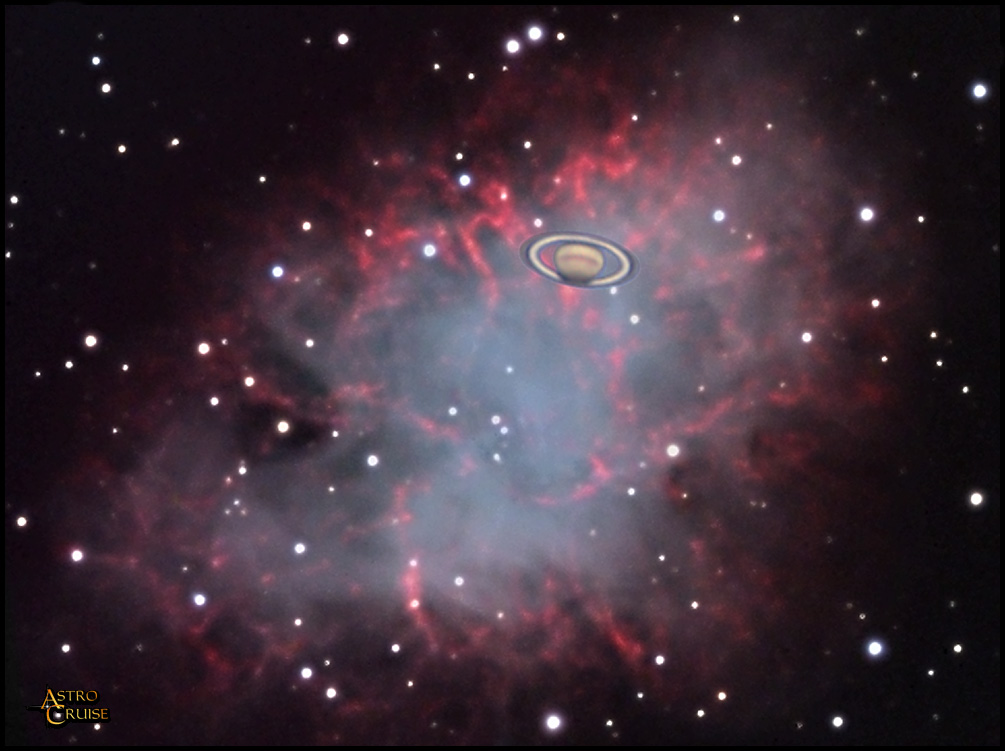
 |
Object data: On the night of 4th/5th January 2003 there was a rare conjunction of Saturn and M1 (Crab Nebula), whereby the orbital motion of Saturn made it appear to pass in front of M1. This image shows the position of Saturn at 01:52 UT on 5th January 2003 from Wiltshire, England. For reasons explained below this image needed to be composited from two separate exposures, so a technique was used to ensure precise registration of Saturn's position on the M1 image at the time it was imaged (please see below). The M1 image had been acquired previously on 20/12/01 during a trip to southern France but had not been processed because only 5 frames had been acquired which were not considered optimum.
The Crab Nebula is the most famous and conspicuous known supernova remnant, a cloud of gas created in a star explosion (supernova) and recorded on 4th July, 1054 A.D. by Chinese astronomers. It was about four times brighter than Venus and was visible in daylight for 23 days! It was discovered by Messier on 28 August, 1758 and numbered 1 in his catalogue (as presumably his first mistaken 'comet') although it was independently discovered earlier by John Bevis in 1731.
Date: Saturn: 05/01/03: 01:52 / M1: 20/12/01
Location: Saturn: Wiltshire England / M1: southern France
Conditions: Calm, -4 C, transparency=7, seeing=7 (5 for M1 image)
Optics: RCOS Ritchey-Chretien 12.5" working at f/9
Mount: AP 900 GTO on Portable Pier
Camera: SBIG ST-8E / CFW-8
Guiding: ST-8E integral guiding chip controlled by MaximCCD (M1 image only)
Exposure: Saturn: RGB: .02; .02; .04 seconds / M1: LRGB: Luminance: 5x15 minutes; RGB: 15:15:30 minutes binned 2x2Processing: Image acquisition and initial processing was done using Maxim CCD/DL, subsequent processing was done using Maxim DL, AIP, Picture Window, and Photoshop.
Registration Technique
Saturn and M1 could not be imaged simultaneously because of the huge difference in brightness. Applying the correct exposure for M1 causes Saturn to swamp the image of M1 as shown in the 15 minute exposure to the right - M1 is completely obscured behind the flare of Saturn. Therefore the two objects needed to be imaged separately and later composited. So the result is somewhat 'artificial' but only because there was no other way of replicating the real event and showing the two objects simultaneously. The image is otherwise quite 'real':
Saturn's size, angle, and position with respect to M1 is correct (within arcseconds) for the time it was recorded: 01:52 hrs UT on 5th January 2003
M1 and Saturn were recorded using the same optical configuration and imaging device
A technique was used to ensure that Saturn was accurately registered to its true position on the image of M1. A set of RGB exposures of Saturn was taken using the correct exposure for Saturn - these were processed normally and formed the Saturn image as seen above. Immediately following this a 30 second white light image was taken. This exposure was long enough to show both the moons of Saturn and the brightest stars in M1 - this was called the "Registration Image". There was considerable flare around Saturn's image but this was edited out by progressively selecting and darkening the flared region. The white disks from Saturn and its moons were somewhat enlarged due to over exposure - these were filled with blue since colour differentiation would help the registration process and help differentiate the moons from stars.
Firstly the Registration Image was registered to some of the brightest stars in the M1 image. Picture Window was used rather than Registar since this allowed the registration stars to be selected manually (Saturn and its moons would have confused Registar). Next, the Saturn image was registered to the Registration image using all of the visible moons (again using Picture Window). The three images: M1, the Registration Image, and the Saturn image, were then copied into Layers in Photoshop (using 50% opacity in the case of the latter two) to check for precise registration. This stack is shown to the right with annotations. Blending adjustments were applied to the Saturn image and the moons were edited out since there was slight orbital motion between the RGB frames. Finally the Registration Image was made invisible and the stack flattened.
|
|
|
|